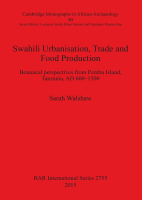Description
BOOK DESCRIPTION
This monograph examines Swahili plant subsistence and food production patterns through the analysis of macrobotanical remains from four archaeological sites on Pemba Island, Tanzania, dating to A.D. 700-1600. Specifically towns and villages are compared before and during the emergence of stonetowns, settlements characterized by stone/coral household and ritual architecture, which have been described as urban, based on their roles as economic, political, and religious centers along the eastern African coast. Swahili stonetowns are hypothesized to have exerted political control over the immediate hinterland for the purposes of obtaining trade items and staple goods, including plant products. Based on ethnohistoric reports, a wide variety of collected and cultivated plants have been previously proposed as being central to Swahili consumption and production economies including trees in mangrove habitats, coconut, sorghum, pearl millet, and Asian rice. Moreover, it has often been assumed that stonetowns obtained plant products, including staple grains, from the countryside and were not themselves primary food producers. These assumptions are tested directly against the archaeological record in this first comprehensive study of ancient Swahili plant foods.
REVIEW
‘...a timely addition to the literature.. In conclusion, detailed analyses such as that presented in this book are important for understanding both local practices and the nature of different nodes in the regional economies. Walshaw’s book is thus a welcome contribution to our knowledge of the East African coast and of the effects of urbanisation on food production, providing both essential data and nuanced contextual analyses.’
Daphne Gallagher, Azania: Archaeological Research in Africa, 52:2, 2017











